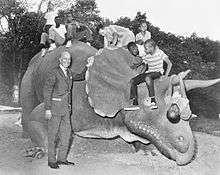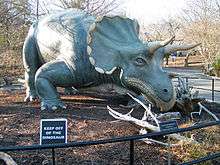Uncle Beazley
| Year | 1964 |
|---|---|
| Type | Fiberglass |
| Location | Near Lemur Island in National Zoo, Washington, D.C. |
| 38°55′44″N 77°2′52″W / 38.92889°N 77.04778°W | |
| Owner | Smithsonian Institution |



Uncle Beazley is a life-size fiberglass statue of a triceratops by Louis Paul Jonas.[1][2] It is located near Lemur Island[3] in the National Zoological Park (the National Zoo) in Northwest Washington, D.C.[2]
The statue is named after a dinosaur in the children's book The Enormous Egg (1956), by Oliver Butterworth, and a movie adaptation televised on the NBC Children's Theatre in which the statue appeared.[1][2][4] The book and the film, which aired on April 18, 1968, tell the story of a boy who finds an enormous egg laid by a hen that hatches a baby triceratops.[1][2][4] The triceratops, named Uncle Beazley, becomes too big, so the boy brings him to the Smithsonian Institution.[2] Beazley is first kept at National Museum of Natural History, but is eventually transferred to the National Zoo’s Elephant House because there is a law against stabling large animals in the District of Columbia.[1][2]
The statue is one of nine dinosaurs of different species that Jonas designed and constructed for the Sinclair Oil Corporation's pavilion at the 1964 New York World's Fair in consultation with paleontologists Barnum Brown and Edwin H. Colbert of the American Museum of Natural History in New York City and John Ostrom of the Peabody Museum of Natural History at Yale University. After the Fair closed, the statue was featured in Sinclair's traveling Dinoland display.[1][2][5][6]
In 1967, Sinclair donated the nine dinosaurs to various American museums and the Smithsonian.[1][2] The Smithsonian's “Uncle Beazley” was initially displayed at the Zoo.[2] In July 1967, a crew from NBC-TV visited the Zoo to film the statue during the production of The Enormous Egg. After the filming ended, Sinclair donated the statue to the Smithsonian.[7]
Uncle Beazley was present at the Smithsonian's Anacostia Neighborhood Museum when the museum opened on September 15, 1967.[8] From the 1970s to 1994, the statue was located at the National Mall in front of the National Museum of Natural History.[2][9] In 1994, the statue was returned to the Zoo and was displayed in the former rhinoceros yard until 2003, when the yard was renovated for the Zoo’s expanding Asian elephant family.[2][10]
In 2007, the Zoo and Smithsonian exhibits staff began work to restore the dinosaur.[2] Zoo staff also created a garden exhibit for Uncle Beazley near Lemur Island with funding from a gift from a Director’s Circle donor in memory of her parents.[2][11] The “dinosaur garden” features plants such as ferns, papyrus, and giant taro whose ancestors existed during the age of the dinosaurs.[2][11] The statue was again refurbished in 2011.[5][12]
NBC's telecast of The Enormous Egg also featured five smaller triceratops models that Louis Paul Jonas had created to represent the dinosaur during its youth.[7][13] In 1979, George Heinemann, the telecast's producer, donated the models to Pittsfield's Berkshire Museum, a Smithsonian Affiliate organization in Western Massachusetts. In 2014, the five models, the largest of which bears the name of "Uncle Beazley", were moved to Pittsfield's public library, the Berkshire Athenaeum.[14]
References
- 1 2 3 4 5 6 Goode, James M. (1974). Uncle Beazley. The Outdoor Sculpture of Washington, D.C.: A Comprehensive Historical Guide. Washington, D.C.: Smithsonian Institution Press. p. 260. ISBN 9780881032338. OCLC 2610663. Retrieved 2016-07-04.
This 25-foot long replica of a Triceratops ... was placed on the Mall in 1967. ...
The full-size Triceratops replica and eight other types of dinosaurs were designed by two prominent paleontologists, Dr. Barnum Brown of the American Museum of Natural History, in New York City, and Dr. John Ostrom of the Peabody Museum, in Peabody, Massachusetts. The sculptor, Louis Paul Jonas, executed these prehistoric animals in fiberglass, after the designs of Barnum and Ostrom, for the Sinclair Refining Company's Pavilion at the New York World's Fair of 1964. After the Fair closed, the nine dinosaurs, which weighed between 2 and 4 tons each, were placed on trucks and taken on a tour of the eastern United States. The Sinclair Refining Company promoted the tour for public relations and advertising purposes, since their trademark was the dinosaur. In 1967, the nine dinosaurs were given to various American museums.
This particular replica was used for the filming of The Enormous Egg, a movie made by the National Broadcasting Company for television, based on a children's book of the same name by Oliver Buttersworth. The movie features an enormous egg, out of which hatches a baby Tricerotops; the boy consults with the Smithsonian Institution which accepts Uncle Beazley for the National Zoo. - 1 2 3 4 5 6 7 8 9 10 11 12 13 14 "A Dinosaur at the Zoo". Art at the National Zoo. Washington, D.C.: Smithsonian National Zoological Park. Archived from the original on June 12, 2007. Retrieved July 1, 2016.
- ↑ "Map of National Zoo showing Lemur Island" (PDF). Smithsonian National Zoo Sensory Map. Washington, D.C.: Smithsonian Institution. Archived from the original (PDF) on August 15, 2016. Retrieved October 2, 2016.
- 1 2 (1) Butterworth, Oliver, illustrated by Louis Darling (1956). The Enormous Egg. Boston, Massachusetts: Little, Brown and Co. ISBN 0590475460. OCLC 299175. Retrieved July 4, 2016.
(2) "About this book". The Enormous Egg by Oliver Butterworth, illustrated by Louis Darling. Scholastic Inc. 2016. Archived from the original on July 31, 2012. Retrieved July 3, 2016.At first Nate doesn't see what all the fuss is all about. All he wants is to keep his new pet. But Uncle Beazley, the dinosaur himself, just keeps getting bigger and bigger...
(3) "NBC Children's Theatre (1963–1973): The Enormous Egg: Episode aired 18 April 1968". IMDb.com, Inc. 2008. Archived from the original on March 9, 2008. Retrieved July 3, 2016.
(4) MacIntyre, F Gwynplaine (May 28, 2003). "User Comment". NBC Children's Theatre (1963–1973): The Enormous Egg: Episode aired 18 April 1968. IMDb.com, Inc. Archived from the original on March 9, 2008. Retrieved July 3, 2016. - 1 2 Dukehart, Coburn (February 16, 2011). "Uncle Beazley Is On The Move". The Picture Show. NPR. Archived from the original on October 3, 2015. Retrieved July 2, 2016.
- ↑ (1) "Sinclair at the New York World's Fair". 1960s. Sinclair Oil Corporation. Archived from the original on May 5, 2016. Retrieved July 4, 2016.
(2) "Sinclair's New York World's Fair (1964-65) "Dinoland" Pavilion". Sinclair History. Sinclair Oil Corporation. 2013. Archived from the original on May 9, 2015. Retrieved July 11, 2016.
(3) "Dinosaur Fever – Sinclair's Icon". Petroleum History Almanac. Washington, D.C.: American Oil & Gas Historical Society. 2016. Archived from the original on April 10, 2016. Retrieved July 2, 2016.
(4) "Sinclair Dinoland: New York World's Fair 1964-65". Science Leads the Way. Frank J. Leskovitz. 2016. Archived from the original on March 5, 2016. Retrieved July 2, 2016. - 1 2 National Zoological Park (U.S.) (July, 1967). "NBC-TV films at NZP". Chronology of Smithsonian History: Smithsonian Institution Archives. Smithsonian Institution. Retrieved July 20, 2016.
A crew from NBC-TV arrives at the National Zoological Park to film scenes for the NBC Children's Theater TV special, "The Enormous Egg," based on a children's book written by Oliver Butterworth. The triceratops of the story, named Uncle Beazley, is depicted by seven different models varying in size from just hatched to full size. The models were made by sculptor Louis Paul Jonas specifically for the Enormous Egg production. Jonas was also the creator of the dinosaurs for the New York World's Fair of 1964. The Sinclair Oil Company will donate the life-size model (22 feet) to the Smithsonian after the filming.
- ↑ "S. Dillon Ripley & "Uncle Beazley"". Smithsonian Institution Archives. September 15, 1967. Archived from the original on November 15, 2011. Retrieved July 2, 2016.
Secretary S. Dillon Ripley (1964-1984) and unidentified children with "Uncle Beazley", the dinosaur (Triceratops) used in the film "The Enormous Egg", at the opening of the Anacostia Neighborhood Museum on September 15, 1967.
- ↑ (1) "Uncle Beazley". Histories of the National Mall. Fairfax, Virginia: Roy Rosenzweig Center for History and New Media, George Mason University. Archived from the original on April 16, 2016. Retrieved July 1, 2016.
For a slow-moving dinosaur, Uncle Beazley is widely traveled. Before coming to the Mall in the 1970s, his home was the Smithsonian's Anacostia Neighborhood Museum. In 1994, Uncle Beazley moved from the Mall to his current residence, the National Zoo.
(2) "Uncle Beazley on the Mall". Historic Images of the Smithsonian. Smithsonian Institution Research Information System. 1976. Retrieved July 2, 2016.Six children play on the sculpture "Uncle Beazley," the 25 foot long replica of a triceratops, placed on the Mall in front of the National Museum of Natural History (NMNH).
(3) National Zoological Park (U.S.) (1977). "Uncle Beazley in the Snow". Historic Images of the Smithsonian: Smithsonian Institution Archives. Smithsonian Institution. Retrieved July 20, 2016.Fiberglass model of "Uncle Beazley," the dinosaur (Triceratops) used in the film "The Enormous Egg," stands all covered with snow on the Mall. The Smithsonian Institution Building is visible in the background.
- ↑ National Zoological Park (U.S.) (May 1994). "Uncle Beazley Moves to the Zoo". Chronology of Smithsonian History: Smithsonian Institution Archives. Smithsonian Institution. Retrieved July 20, 2016.
Uncle Beazley, the 25 foot long replica of a triceratops that resided on The Mall in front of the National Museum of Natural History for many years, has found a new home in the Rhino Yard near the Elephant House at the National Zoological Park. Uncle Beazley first appeared in the children's book "The Enormous Egg" by Oliver Buttersworth. There was a ceremony to welcome him to his new home on June 8 attended by fifth-graders from the Bancroft Elementary School and Myer Elementary School. The ceremony was hosted by Research Paleontologist Emeritus Nicholas Hotton and the Zoo's Associate Director for Interpretive Programs David Jenkins.
- 1 2 Switek, Brian (June 24, 2009). "A Triceratops at the National Zoo". Smithsonian.com. Retrieved July 2, 2016.
- ↑ (1) Weil, Martin (February 20, 2011). "Aging 'Uncle Beazley' leaves National Zoo for 'treatment'". Metro. The Washington Post. Retrieved August 17, 2016.
(2) "Uncle Beazley Has Arrived". Smithsonian Institution Office of Exhibits Central. March 1, 2011. Archived from the original on September 11, 2015. Retrieved July 2, 2016.
(3) "Makeover for National Zoo's Uncle Beazley". LandscapeOnline.com. Landscape Communications, Inc. November 28, 2011. Archived from the original on November 28, 2011. Retrieved July 2, 2016.
(4) "Uncle Beazley Gets a Facelift (May 2011)". Art at the National Zoo. Washington, D.C.: Smithsonian National Zoological Park. Archived from the original on October 10, 2012. Retrieved July 1, 2016.
(5) Childs, Arcynta Ali (May 3, 2011). "An Old Favorite Returns to the National Zoo". Smithsonian.com. Retrieved July 2, 2016. - ↑ (1) National Zoological Park (U.S.) (1967). "Louis Paul Jonas with Uncle Beazley". Historic Images of the Smithsonian: Smithsonian Institution Archives. Smithsonian Institution. Retrieved August 19, 2016.
At the National Zoological Park, Louis Paul Jonas, designer of the fiberglass sculpture of a dinosaur triceratops named Uncle Beazley used in the NBC production of 'The Enormous Egg', is with a model of Uncle Beazley as a baby.
(2) National Zoological Park (U.S.) (1967). "Louis Paul Jonas with Uncle Beazley". Historic Images of the Smithsonian: Smithsonian Institution Archives. Smithsonian Institution. Retrieved August 19, 2016.Louis Paul Jonas, designer of the Uncle Beazley fiberglass triceratops sculpture used in the NBC production of 'The Enormous Egg,' holds up a model of a baby Uncle Beazley sitting on vegetation to a giraffe in the Elephant House at the National Zoological Park.
- ↑ "Uncle Beazley's New Home". Pittsfield, Massachusetts: Berkshire Museum. 2015. Archived from the original on August 19, 2016. Retrieved August 19, 2016.
External links
| Wikimedia Commons has media related to Uncle Beazley. |